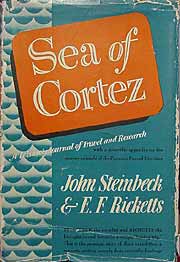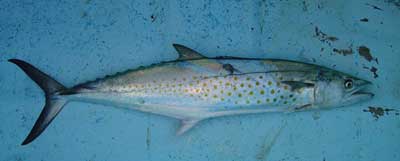这是昨天受朋友之托翻译的小文章,发表在《文汇读书周报》上,原作者和出处不详。
============================
重走斯坦贝克之旅
阮一峰 译 / 2004.2.9

斯坦贝克在完成小说《愤怒的葡萄》后深感疲倦,于是1940年他邀请好友里凯茨(Edward F. Ricketts)一同出海,乘坐一条捕捞沙丁鱼的小船,在加利福尼亚附近的海域进行了一次为期6周的科学和文学的探险。

这次旅行因为斯坦贝克的《科特斯海航行日志》(The Log From the Sea of Cortez)而闻名,很多科学家和旅行爱好者都想重走这条路线。现年已经80多岁的里凯茨的孙子说:"几十年来,人们总在谈论这件事,但没有人实践过,"
现在,这种局面将被打破。
今年3月11日,在那次旅行正好满64周年的纪念日,四男一女将乘坐一样的木制小船,从蒙特里下海,航行 4000英里,到达科特斯海后,再折回,与当年的路线完全相同。
这次历时两个月的旅行将由圣何塞大学斯坦贝克学者、自由作家克里斯腾森(Jon Christensen)负责每日记录,他计划将把这些记录汇集成书后出版,并且还要在网络上建立一个逐日更新的网络日志,供孩子们和所有感兴趣的人浏览,网址为 http://www.seaofcortez.org 。
斯坦福大学海洋学教授吉里(William F. Gilly)是四人中的主要科学家。他计划调查当年里凯茨提到过的550种海洋生物。根据里凯茨的笔记,科学家们将确保航行路线和停泊地点完全相同。这样做是为了使他们的观察和采集样本与64年前所做的具有最大的可比性。
和当代的大多数科学考察不同,本次探险的预算非常微薄。但与前者相同的是,它也是某个晚上"啤酒聚会"的产物。吉里从80年代中期开始,就有这样的打算,但只有当他将这个想法告诉快要退休的多纳休(Frank Donahue)后,此事才变得明确起来。多纳休从事捕虾,自己有一条船,他的反应是:"没有其他事比这个更值得做了"。
多纳休的船对这次考察来说,有些过于"强大"了。他开玩笑说:"这好比开着大卡车去郊游。"在出发前,他将船上的柴油机卸下,其他的成员也帮忙一起清理、收拾和油漆这艘小船。它还需要被拖出水,以便刮去附在船底的藤壶和海藻。
多纳休预期所有准备工作可以在出发前顺利完成。他也认为本次航行对他来说非常轻松,至少比出海捕捞容易,因为"没有经营的压力,我要做的只是开船而已。"
旅行的初步成本为9万美元,这笔钱大部分来自私人捐助和非赢利团体。吉里还正在为找到其他的赞助者而努力。一家啤酒公司已经同意捐出50-70箱的啤酒,以便保持原始航行的精神。在斯坦贝克的记载中,曾经多次提到过啤酒。
虽然这次航行是重复斯坦贝克和里凯茨路线的第一次尝试,但早在原始的《科特斯海航行日志》中就提出过要再一次进行类似的探险活动。斯坦贝克这样写道:"我们认为,所有对未知地区的考察活动都应该进行两次,一次用来犯错误,另一次用来纠正它们。"

===============================
英语原文如下:
重走斯坦贝克之旅
MONTEREY, Calif. -- Weary from writing "The Grapes of Wrath," John Steinbeck set sail from here in 1940 with his pal, Edward F. Ricketts, on a sardine boat that ferried them on a six-week scientific and literary adventure around the Baja California peninsula.
The expedition, made famous by Steinbeck's account, "The Log From the Sea of Cortez," has long made scientists and armchair adventurers dream of re-creating the seafaring voyage of the novelist and the marine biologist who was the model for the character Doc in the novel "Cannery Row."
"People have talked about doing this for decades," said Edward F. Ricketts Jr., the octogenarian son of Monterey's famous marine biologist, who died in 1948. "But it's never been done."
Until now.
On March 11, 64 years to the day after Steinbeck and Ricketts set off in a chartered fishing vessel, four men and one woman plan to board a remarkably similar wooden fishing boat in Monterey and trace the same 4,000-mile route to the Sea of Cortes and back again.
The two-month trip will be chronicled by a Steinbeck Fellow, an academic position at San Jose State University held by freelance writer Jon Christensen. He plans to write a book about the expedition and create a daily Web log on the Internet for schoolchildren and others to follow.
The chief scientist will be William F. Gilly, a Stanford professor of marine science based at the Hopkins Marine Laboratory in Monterey.
As in the first expedition, Gilly and other scientists plan to survey the shallows for the 550 types of marine life listed by Ricketts in the original book he co-wrote with Steinbeck: "Sea of Cortez: A Leisurely Journal of Travel and Research."
Using a recently rediscovered copy of Ricketts' notes from the trip, the scientists plan to trace the precise route and make the same stops.
The idea is to compare their observations and freshly collected species of marine life with those plucked from the sea and logged 64 years ago.
They want to measure what has happened to the body of water -- once so rich in marine life that explorer Jacques Cousteau called it the "aquarium of the world," but one that has suffered from decades of excessive fishing and pressure from unchecked tourist development around Cabo San Lucas.
"What do I hope to get out of it?" Gilly asked. "I hope we will learn what has stayed the same, what has been lost.
"I also hope it will be an odyssey," he said, explaining his yearning to get out of the lab and into the field for exploration and discovery.
"Everything down there is mysterious and has many truths to reveal," Gilly said. "I don't know exactly where to look, so I want to look everywhere, especially around that next rocky point."
The scientific survey will be more systematic than Ricketts' original investigation and is to include two extra weeks to look for species, such as the jumbo Humboldt squid, not mentioned by Ricketts or Steinbeck. The squid, which can reach 100 pounds and 6 to 9 feet in length, now are the target of a major fishery in the Gulf of California, the formal name of the Sea of Cortes.
Gilly, a neurobiologist who has been studying squid, plans to go to spots in the Gulf of California where sperm whales congregate to feed on those mysterious tentacled creatures, which can change colors from white to deep red.
Unlike most modern-day scientific expeditions, this one will be operated on a shoestring budget. Yet like many adventures, it was conceived "over some beers" one evening, Gilly said.
He has been thinking about duplicating the voyage since the mid-1980s, but the idea took shape only after he linked up with Frank Donahue, a semiretired shrimp fishermen with a boat and, as he puts it, "nothing better to do."
The boat, docked in Morro Bay, is more functional than fancy. "It's like going to a picnic in a dump truck," Donahue said, greeting all comers with a barrage of jokes. He lives aboard the 73-foot Gus D, named after his late father, and is proud of the sturdy vessel he has taken all over the Pacific. "She can go 12,000 miles on a tank of gas. That would get you to Indonesia."
Donahue has the diesel engine torn apart, pieces scattered everywhere in the midst of an overhaul. Other members of the expedition have been making regular trips to Morro Bay to help out, cleaning, painting and organizing. The boat needs to be hauled out of the water to have barnacles and algae scraped from its bottom before it motors up to Monterey to begin the trip.
Donahue expects everything to be ship-shape by the departure date. He also predicts the cruise will be easy for him -- at least easier than fishing. "I don't have to catch fish or sell 'em. Or try to make a living. All I have to do is keep the ship running."
With the trip's $90,000 basic costs covered by grants from private donors and nonprofit groups, Gilly is trying to line up sponsors for food and amenities. North Coast Brewing Co. in Mendocino has pledged 50 to 70 cases of beer in keeping with the spirit of the original trip. The log mentions considerable sampling of cerveza, or beer, in Spanish.
Christensen, meanwhile, is working with the San Diego Natural History Museum's binational education program to design a guide for teachers to help their students understand the significance of the trip and follow along. Christensen plans to produce a daily log of the trip and use a satellite hookup to post it in English and in Spanish on http://www.seaofcortez.org or http://www.mardecortes.org .
The scientists also plan to bring groups of schoolchildren from La Paz, Loreto and Santa Rosalia on the Baja Peninsula to help them collect specimens, and perhaps learn a greater appreciation for marine life and the ocean.
Again, the idea is modeled after an experience by Ricketts and Steinbeck. In a passage from the log, Steinbeck wrote about boys who danced around them, quizzing them about what they were searching for in the tidal flats near La Paz.
"Once they know you are generally curious, they bring amazing things," Steinbeck wrote. "Small boys were the best collectors in the world."
With sharp eyes, the boys came up with ingenious ways to collect shrimp and other creatures without having their fingers pinched, he wrote. "[T]hen ten-centavo pieces began running out, and an increasing cloud of little boys brought us specimens."
The expedition's regular members plan to pick up visiting scientists for portions of the trip. But joining Gilly, Christensen and Donahue for the entire voyage will be Chuck Baxter, a retired Stanford University lecturer of marine science, and Nancy Burnett, a photographer and video documentary maker who co-founded the Monterey Bay Aquarium.
Although the expedition would be the first to follow in the historic wake of Steinbeck and Ricketts, the idea of another Sea of Cortes adventure surfaced in the original log.
"We have concluded," Steinbeck wrote, "that all collecting trips to fairly unknown regions should be made twice: once to make mistakes and once to correct them."
(完)


我要发表看法